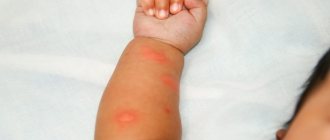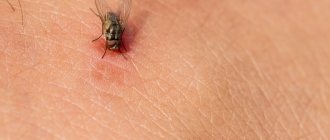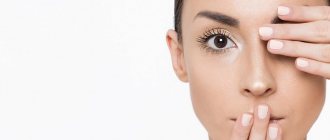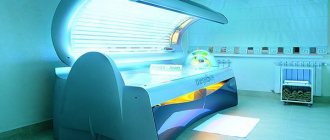Many women prefer to dye their hair and eyebrows with natural dyes, which include henna. It is considered the most accessible, harmless and hypoallergenic. However, like any cosmetic product, this product can cause an allergic reaction in the body. How does an allergy manifest itself, and what to do when it appears?
Is there an allergy to henna?
Henna is obtained from the leaves of the lawsonia shrub, which grows in hot countries. It has long been used as a dye that can not only change the color of hair/eyebrows, but also nails. Now the scope of henna has become more extensive. It is used to perform tattooing and various designs on the body. And thanks to its disinfecting properties, henna is used for medical purposes to treat dermatological ailments and treat skin wounds.
Many people wonder if there is an allergy to henna. Experts give an affirmative answer to this, although such cases are rare.
History of the spread of henna
It is suggested that the coloring properties of Lawsonia
people learned by observing domestic ruminants that grazed in the areas where it grew. The shepherds began to notice that after grazing the flock, some animals' saliva and muzzle turned bloody. Fearing bleeding, people began to actively monitor what their livestock ate and discovered the coloring property of henna leaves.
There is a misconception that the tradition of using henna for coloring originated in India, but it dates back to 7000 BC. The Indian subcontinent was wetter and cooler than it is today, and therefore henna would not have grown in these ecosystems.
Home to Lawsonia
is the Sahara Desert (presumably what is now Sudan), where it originated more than 15,000 years ago during a climatic period that historians call the “green Sahara” phase.
Due to dramatic climate change around 10,000 B.C. and 4500 BC the population of the Sahara migrated to the northeast towards the Arabian Peninsula, Mesopotamia and India, which contributed to the migration of many species of animals and plants, including Lawsonia inermis
.
In Egypt in 1500 BC. henna was called "kupros" or "cyperus" and various parts of this plant were used to create medicines. It was mainly used in the treatment of lice and ringworm, and also as an anti-inflammatory agent, and only through familiarization with the traditions of their neighbors from the Eastern Mediterranean did the Egyptians begin to use Lawsonia
in everyday life, in particular as a dye for hair and nails. The resulting dye also gave fabrics a beautiful crimson color and served as decoration for the walls of tombs [2, 3].
The mechanism of allergies
The body's immune response occurs depending on how the coloring agent is used. If the hair part of the body (head, eyebrows) is dyed with it, a reaction is observed almost immediately. If alarming symptoms appear, you should immediately rinse the stained area with water (preferably several times) and contact an allergist.
When performing tattooing and painting, in addition to henna, other components are added to the coloring composition: coffee, colored clay, indigo. Therefore, an allergy can occur to any of the dyes, just as quickly as when applied to the hair.
Reminder for eyebrow care after henna dyeing
Henna is a natural and safe product. It does not cause skin irritation or allergic reactions, and it will make your eyebrows look natural. However, in order for the result to last for a longer period, it is necessary to follow the rules for care after tinting your eyebrows with henna.
The experts give their recommendations on how to keep them well-groomed, consolidate the result after treatment with a cosmetic product, and prolong the effect of coloring.
- Prohibitions after the procedure
After tinting your eyebrows with henna, you need to treat them with care. In salons, masters give clients notices with prohibitions that cannot be violated. If the instructions are not followed, the color of the eyebrows may quickly fade. Without proper and necessary care, even high-quality cosmetics will not be able to maintain their effect for a long time.
The after-staining care instructions say:
- Do not use cosmetics that contain aggressive substances;
- It is forbidden to wet eyebrows after coloring for 24 hours;
- Ultraviolet radiation (sun, solarium) should be avoided;
- the first day you can’t go to the sauna;
- Do not rub your eyebrows with cotton pads or a hard towel.
Experts recommend washing your face carefully to preserve the biotattoo effect. All prohibitions apply only for the first day after dyeing. The remaining rules must be followed constantly, until the next painting.
- Combing and massage
To correct eyebrows with henna, specialists use sets of brushes, brushes, tweezers, combs and other devices for care and coloring. To achieve the desired shape, a smooth curve, and a rich natural color, makeup artists remove excess hair, tint the eyebrows, style them, and fix the created shape.
Experts believe that girls definitely need to take care of their henna-dyed eyebrows. The most important thing to do to maintain color saturation is to comb your eyebrows and massage.
Recommended reading:
- What not to do after eyelash extensions
- Which eyelash extension to choose for yourself
- Eyelash care: advice from professionals
To comb, you need to take a brush with stiff hairs. You can use an old mascara brush. This brush should be used morning and evening before bed, moving it in the direction of hair growth. Thanks to this, blood circulation will improve, metabolic processes in the skin will be normalized, and the bristles will be smoothed out. This procedure prevents rapid fading and also promotes hair growth.
Massage your eyebrows. This stimulates blood flow, improves metabolic processes and hair growth. Apply pressure on the arches with your fingertips and in a circular motion. But don't use force. Touches should be light, without strong pressure. You can pinch a little. Eyebrow experts recommend massage 2 times a week, but not immediately after coloring.
Hygienic care should be carried out with a special makeup remover milk. Soap solutions are not suitable; they can cause the henna to fade.
Correction will help maintain a well-groomed shape. Remove excess regrown hairs in the salon or at home. Before the procedure, it is necessary to treat the eyebrow area with an antiseptic that does not stain the skin.
- Using masks and oils
Another way to preserve biotattoo. It is necessary to choose oils and masks with natural composition. Experts recommend almond or eucalyptus oils for this. They carefully care for the skin and prevent hair dulling. To prepare the mask, you need:
- mix beeswax, petroleum jelly, linseed oil in a ratio of 1:1:1;
- Apply the resulting mixture to the area in the eyebrow area, do not rub;
- Do not wash off the mask, but leave it to absorb the necessary substances.
It can be applied with a brush. Eyebrow experts recommend carrying out the procedure several times a week. The ingredients that make up the mask nourish the skin and stimulate hair growth.
Makeup artists also call henna dyeing biotattoo with a care effect. If the hairs are sparse, the result after dyeing will be too eye-catching due to the pigment on the skin. To make it less bright, you can rub the area with grape seed oil.
Sign up for eyelash extensions at Anna Klyuchko's studios with a 15% discount until March 6
12 studios throughout Moscow, St. Petersburg, Nizhny Novgorod and Tula
223 masters for every taste
High-quality service with a 7-day guarantee
Regular promotions and gifts for clients
Full volume 1990₽ 1692₽ Double volume 2590₽ 2202₽ Triple volume 2890₽ 2457₽ Hollywood volume 3400₽ 2890₽
Book 15% discount
- Washing after coloring
Girls like beautiful, well-groomed eyebrows. To ensure that the result is 100% perfect, they use the services of experienced eyebrow specialists. If the client has chosen the method of dyeing with henna, the makeup artist gives recommendations on how to care for her eyebrows and what not to do. One of the prohibitions is contact of eyebrows with moisture after coloring.
Any competent master will tell you that hygiene procedures in the first 24 hours after henna dyeing lead to fading of the pigment. The bright and rich color is quite easy to wash off.
Within 24 hours after the procedure, the active components penetrate the skin, and water prevents this and washes away all substances.
For the first 2 days after coloring, it is better not to touch, rub or wet your eyebrows. This is indicated in the care instructions. Otherwise, the correction will be useless. As a result, eyebrows after dyeing with henna will wash off in a few days. If you follow all the instructions of the master, the result will last for 5-7 weeks.
Causes of hypersensitivity
If after dyeing your eyebrows, eyelashes, hair, or skin an allergy begins, then the cause should be sought in:
- poor quality product;
- the presence of synthetic components that enhance the coloring properties of henna;
- environmental influences on shrubs during growth;
- using chemical fertilizers, spraying the bush while caring for it;
- weak immunity;
- hypersensitivity to henna.
Important! Allergies often occur after henna. If a low-quality product was used, flavored with a large number of chemical components.
Influence of skin type
Hypersensitive, thin, injured, excessively dry skin is one of the main causes of allergies after henna. Aggressive elements that are included in the coloring product are instantly absorbed into the bloodstream, provoking a negative reaction in the body. After dyeing eyebrows with henna, allergic symptoms are observed much more often, since the skin around the eyes is thinner and more sensitive than on the head.
What in the composition causes allergies?
In addition to the natural substance, manufacturers can add to the coloring composition:
- isatin – giving a red tint;
- P-Methylaminophenol;
- 6-hydroxyindole.
The most dangerous of all is paraphenylenediamine, which gives a persistent, indelible color after applying henna. This element can be found in any hair and eyebrow dyes. A dye without this substance will cost much more.
Which henna often causes a reaction?
There are several types of henna: Indian, Turkish, Egyptian, Sudanese, Iranian. It is produced in bright orange, colorless or black powder. The most popular brands are Sexy brow henna, Lady Henna, Venita henna, SS brow. To dye, just dilute the powder with water and apply to the desired area, following the instructions.
Often a pronounced reaction is caused by black henna, which does not exist in nature. Chemicals added to the powder can cause severe swelling and burns, especially when applied to the eyes and eyebrows.
Brow henna eyebrow dye is available in a variety of colors: black, light brown, dark brown. It can cause allergies, since in addition to henna it contains many synthetic dyes. Therefore, before applying the product, you must do a sensitivity test.
Clinical observation
Patient P.
, 10 years old, applied to the Children's City Clinical Hospital named after. BEHIND. Bashlyaeva" 08/16/16 with complaints of rashes on the left shoulder. From the anamnesis it is known that the patient returned from Turkey 3 days ago, where a henna design (“temporary tattoo”) was applied to the shoulder twice. After the first application of paint, no manifestations of dermatitis were observed. After repeating the drawing, 1 day later, redness of the skin, severe itching, and subsequently a blistering rash appeared at the tattoo site. The patient was hospitalized with a diagnosis of acute contact allergic dermatitis.
Upon admission, erythema, multiple vesicles, oozing, and papular elements were noted on the skin of the shoulder, the location of which corresponded to the henna pattern (Fig. 6, a).
Rice.
6. Patient P., 10 years old, with allergic contact dermatitis after applying henna (vesicular elements): before treatment (a); pronounced regression of rashes after therapy with methylprednisolone aceponate once a day for 5 days (b). The following treatment was carried out in the hospital: suprastin 0.5 ml 2 times a day intramuscularly for 3 days, externally once a day 1% brilliant green for 3 days and Advantan
1 time a day for 5 days. After 5 days of therapy, a pronounced positive dynamics of the skin process was observed: the rashes regressed, the crusts fell off, the itching stopped (see Fig. 6, b). In satisfactory condition, the patient was sent to outpatient treatment at his place of residence.
Signs of allergies
If you are allergic to tattoos and henna paint, a person may experience:
- cough, shortness of breath, rhinitis, conjunctivitis;
- swelling of the respiratory canals;
- skin redness;
- rashes, itching, peeling, burning of the skin.
An allergy to henna in people can provoke anaphylactic shock, Quincke's edema, irritation of the gastrointestinal tract, eczema, and dermatitis. Prolonged contact with an irritant aggravates chronic ailments. Against the background of an immune reaction, skin color may change, insomnia and irritability may begin. When re-stained with this dye, the symptoms will intensify.
Allergy to henna for hair
Many women try to use natural dyes. But even to basma and henna, in some cases allergies occur.
In this case, the following are observed:
- itching of the scalp;
- red spots on the skin, blisters;
- hair loss;
- sneezing, watery eyes;
- swelling of the larynx;
- aches in the body and joints;
- difficulty breathing.
Important! An allergy to henna for hair is a dangerous condition that requires immediate treatment.
Reaction to eyebrow and eyelash dye
When an allergy to dyeing eyebrows and eyelashes with henna develops, the following symptoms are observed:
- the formation of itchy nodules, rashes, pigment spots resembling burns;
- the presence of blisters filled with transparent contents during prolonged contact with the irritant;
- severe swelling of the treated areas, nasal congestion, burning in the eyes.
Prolonged exposure to henna on the eyebrows can cause pulmonary edema and bronchospasm, which can be fatal.
Allergy to mehendi
A negative reaction of the body to henna for mehendi occurs due to the fact that a cheap substance paraphenylenediamine is added to the natural dye, which gives a rich black color. As a result, painting on the body with such paint can cause redness, itching, rash, and Quincke's edema.
Burn symptoms
Black henna is the most dangerous to health, since this color does not exist in nature. Chemicals are added to give henna its black color. The most harmful of them is paraphenylenediamine.
Treatment of burns when tinting eyebrows
Eyebrow tinting
In cases where primary treatment does not help, symptoms worsen, chemical burns appear, the first thing to do is consult a doctor. He will determine the complexity of the damage and prescribe effective treatment.
Basically, for these symptoms, other drugs are added to those already used:
- Bepanten
- Antibacterial ointments (Levosin, Levomekol).
- Hormonal agents (Elocom, Fenkalor, Beloderm).
- Healing creams (Bepanten).
- Enterosorbents (activated carbon, Enterosgel).
Excellent remedies that have a restorative and healing effect are traditional medicine tools. Compresses made from a decoction of chamomile and flaxseeds soothe and regenerate the skin well. Moisturize and tone damaged areas with kefir or sour cream lotions.
Henna burn on eyebrows
When dyeing eyebrows with henna, the burn is localized. In this case, symptoms are observed in the form of redness of the eyebrows, rashes on the face, burning and itching.
In some cases, the coloring composition can provoke such negative manifestations as:
- redness of the eyeballs;
- tearing eyes;
- difficulty breathing;
- cough;
- swelling of the airways;
- pain in the area where eyebrow dye is applied;
- rhinitis;
- sneezing;
- general weakness of the body;
- Quincke's edema;
- anaphylactic shock.
Henna tattoo burn
A henna tattoo is applied without pain, it is temporary and is washed off after about 1 month. But it has already been refuted that such patterns do not have a negative effect on the skin.
If the henna used is a natural product, there really won’t be any problems, but usually in such cases mixtures with various additives are used.
Therefore, doctors often have to deal with a reaction to the so-called paraphenylene diamide, which is added to henna to make the dye last longer. Many people are allergic to it, resulting in a burn on the skin that is very itchy and covered with small blisters.
Diagnostics
Often, treatment of henna allergy begins with diagnostic measures. The allergist will listen to the patient’s complaints, conduct a visual examination, collect anamnesis and prescribe the necessary tests: blood tests and skin tests. Based on the results of the examination, it is possible to accurately determine the irritant and determine the treatment tactics.
Blood analysis
In private laboratories, they do special tests for adults and children for indicators of the total level of lymphocytes and immunoglobulin E. If these indicators are elevated, then we can talk about an allergic reaction to a particular irritant.
The main task of antibodies is to neutralize the effect of the allergen. However, healthy cells also suffer, which causes unpleasant symptoms.
Skin tests
Special tests help to understand whether you are allergic to a tattoo, hair dye, eyebrows and eyelashes containing henna. An allergy test is performed in the forearm area, introducing a small amount of allergen and monitoring the body's reaction. No more than 15 stimuli are used in one session. If redness, swelling, or itching occurs at the site of contact with them, then the diagnosis is confirmed.
Who is henna contraindicated for?
Its use is contraindicated for people with dermatitis or dermatoses, neurodermatitis, acne, acute or chronic skin diseases. It happens that a person is genetically predisposed to allergic diseases; such people are also not recommended to use henna.
Sometimes when eyebrows are dyed, shortness of breath, coughing, and swelling of the respiratory organs appear, and all this is accompanied by severe itching, redness, rash, peeling and burning.
The effect of henna has not been fully studied. A particularly dangerous complication is considered to be Quincke's edema, in which swelling of the respiratory organs rapidly increases, causing it to stop.
If all these symptoms appear, you should always seek help from a doctor. Basically, an allergic reaction is caused by the components that are included in henna. Repeatedly painting your nails and eyebrows can worsen your allergies.
If an allergy occurs during coloring, you should immediately stop coloring your eyebrows, hair and eyelashes and start rinsing them with clean water. Next, go to a doctor who will prescribe treatment.
First aid for a reaction
If an allergy to henna for eyebrows develops, what should a woman do and how to improve the condition? Experts advise first of all to thoroughly wash the paint from the skin and take any antihistamine.
It could be:
- Suprastin (costs 120 rubles).
- Zodak (costs 135 rubles).
- Claritin (costs 197 rubles).
Suprastin Zodak Claritin
Ideally, if you administer an intramuscular injection of Dexamethasone (10 ampoules cost 64 rubles). Its effect comes on very quickly. If symptoms increase, you should seek medical help.
If you are allergic to a tattoo, you should add antihistamine ointments to systemic medications, for example, Fenistil (costs from 300 rubles). The presence of deep lesions, blisters, and vesicular rashes requires the use of disinfectants and painkillers, for example, Levomekol ointment (costs 120 rubles).
Important! A pronounced allergy to tattoos, hair and eyebrow dyes based on basma and henna requires consultation with a specialist who will definitely tell you how to treat the pathology. If the body has once reacted to these components, they should not be used in the future.
What are allergic eye diseases?
The symptoms of allergic reactions from the eyes are very diverse. This may be more or less mild redness, itching, blistering rashes, burning on the skin of the eyelids (allergic dermatitis), inflammation of the transparent mucous membrane (allergic conjunctivitis) with lacrimation, itching, etc. However, in some cases, the reaction is much more severe and leads to the rapid development of keratitis (toxic or infectious-allergic inflammation of the cornea), uveitis (allergic inflammation of the circulatory system of the eyeball), even to damage to the retina and optic nerve head.
The most common form of ocular allergic reaction, conjunctivitis, can take both an acute and chronic course. Symptoms are approximately the same in both cases: constant lacrimation, itching or pain in the eye, mucous exudate, characteristic glassy swelling of the conjunctiva (chemosis).
Hay fever, or seasonal hay fever, is a typical and widespread example of an allergic reaction, including an eye reaction, to pollen. In the classic version, the peak of hay fever occurs in August and is caused by one of the most powerful allergens, ragweed pollen - (ragweed belongs to the so-called “quarantine” weeds and must be purposefully destroyed by a special service, which, apparently, is not done everywhere and without special success). Hay fever can also be caused by poplar or dandelion fluff, grass, flowers and any other plants. Allergic conjunctivitis is almost never isolated and is usually accompanied by rhinitis (runny nose), uncontrollable repeated sneezing, rash and itching on the skin; Attacks of allergic bronchial asthma may also develop.
It is somewhat different from the so-called hay fever. spring catarrh is an allergic (kerato-) conjunctivitis, which is also a seasonal disease and develops with the arrival of the warm season. The reason has not been reliably established, but the hypothesis that spring catarrh is based on individually heightened sensitivity (hypersensitivity) to the ultraviolet part of the solar spectrum, which is generally dangerous for the eyes in many aspects, is quite well-reasoned. The role of allergenic pollen cannot be ruled out either. The features of such seasonal allergic inflammation are the incidence only in childhood (mainly in boys), the chronic type of course, the presence in the clinical picture of symptoms of photophobia, increased secretion of tear and mucous fluid; A specific manifestation is also the proliferation of papillary rashes on the inner conjunctiva of the eyelids (“cobblestone pavement”), less often along the limbus - the perimeter of the cornea.
Allergy to contact lenses is considered a special form of allergic reaction, which in most cases deprives patients with refractive errors of the opportunity to use this convenient method of optical correction. The direct allergen can be the lens material itself or the solution in which it is stored, but volatile allergens from the air can also settle on the surface of the lens (for example, when using aerosol hairsprays, insecticides, deodorants, etc.).
Treatment
Therapeutic measures largely depend on how severe the pathological process is and how henna was used.
Elimination
After providing first aid, allergists suggest treating allergies to henna by eliminating it from use. The main advantage of this method is complete safety and the absence of contraindications. It also includes using a hypoallergenic diet, maintaining a healthy lifestyle, and giving up bad habits.
Traditional preparations
Conservative treatment of henna allergy not only eliminates the signs of a pathological reaction, but also helps to normalize the activity of the entire body, eliminating signs of disorder in the internal organs and systems.
With the development of dermatitis, which is often caused by an allergy to tattoos, hormonal and non-hormonal ointments are prescribed:
- Hydrocortisone ointment (costs 28 rubles);
- Advantan cream (costs 520 rubles);
- We see the ointment (costs 103 rubles).
Hydrocortisone Advantan Videstim
To disinfect the skin and prevent infection of the affected areas, use antibacterial ointments, for example, Fucidin (costs 400 rubles). For fever and pain, non-steroidal anti-inflammatory drugs are used:
- Ibuprofen (costs 30 rubles);
- Nimesulide (costs 150 rubles).
Ibuprofen Nimesulide
Enterosorbents help cleanse the body of accumulated toxins and allergens:
- Enterosgel (costs 385 rubles);
- White coal (costs 152 rubles).
White charcoal Enterosgel
Allergy sufferers are advised in advance to purchase special shampoos that help wash off henna on hair and eyebrows if unpleasant symptoms occur. These include Nizoral and Vichy.
If dyeing your eyebrows with henna results in a burn, the doctor prescribes a healing cream based on dexpanthenol or zinc:
- Bepanten Derma (costs 146 rubles);
- Panthenol (costs 225 rubles).
Bepanten Panthenol
ethnoscience
If you are allergic to eyebrow henna, what should you do at home? You can use a decoction of medicinal herbs (chamomile, string, calendula). The medicine reduces inflammation, disinfects the skin, and soothes it. Herbs are also good for allergies on the arms and legs after body painting and temporary tattoos.
In addition, they help:
- Boric acid, which reduces itching and burning. To do this, dilute the product with water and make a compress for 10 minutes.
- Lime juice, which removes hyperemia, itching, redness. Juice and poppy seeds are mixed in equal parts and rubbed into the affected area 1-2 times a day.
- Sandalwood oil mixed with lime juice. Heals the skin.
- Kefir eliminates skin reactions to allergies if you anoint the affected area with it twice a day.
Features of using henna
Eyebrow dyeing with henna
Henna is a natural dye that is made from the lawsonia inermis plant, which grows in North Africa and the Middle East. Lawsonia leaves are dried and ground into powder. Henna contains two dyes: orange lawson and green chlorophyll. Original henna dye can be white or red; in some cases, colored eyebrows acquire a greenish tint.
There are many benefits of tinting eyebrows with henna:
- Naturalness of the product. Henna does not use chemicals that can damage the hair follicle and the structure of the hair itself, and does not destroy its natural pigment.
- Strengthening effect. In addition to the cosmetic effect, henna has a healing effect: it strengthens the eyebrows and protects them from the negative consequences of external influences.
- Affordable price and the ability to use henna at home.
- Safety of the procedure. The product rarely causes allergies; it stains only the upper layers of the skin without penetrating deeper.
In addition to the listed advantages, using henna as a coloring agent has some disadvantages that you should be aware of:
- There are some difficulties in the painting process itself - certain skills will be required, the procedure is longer than when painting with paint.
- The limited color range of natural henna is a maximum of 5 shades.
- The durability of natural dyes is much lower than that of chemical dyes.
Interesting. On sale you can often find black or dark chestnut henna. In nature, such shades of this product do not exist. You should carefully study the composition of henna for the presence and quality of additives. If coffee or basma is present, then this product is safe and natural.
The eyebrow tinting process consists of several stages:
- Preparing the coloring agent. Place 50-100 g of henna in a non-metallic container and dilute it with hot (up to 70 degrees) water, add a few drops of lemon juice. A product should form that resembles a paste in consistency. The paint is tightly covered with film and left for several hours.
- Eyebrow preparation. The face and eyebrows are cleaned of makeup. The eyelids, forehead, bridge of the nose are lubricated with cream. The hair is pulled back into a bun and gloves are put on the hands.
- Application of henna. Eyebrows are painted from the tips to the bridge of the nose. Henna should be distributed evenly. Depending on the desired coloring result, the paint is left for 40-50 minutes.
- The final stage. The dried paste is removed with a cotton pad, the eyebrows are carefully cleaned of henna residues and moisturized with cosmetic oil.
Important! To preserve the results of coloring for a longer period of time, it is necessary to exclude some actions: wash your eyebrows on the first day after the procedure, do peelings, avoid salt water, sauna, solarium
Preventing a reaction
To prevent henna tattoos or dyeing of the hair parts of the body from causing a deterioration in health, you need to pay attention to contraindications to the use of this type of dye:
- dermatosis;
- neurodermatitis;
- acne;
- dermatitis;
- chronic ailments affecting the skin.
You cannot apply henna to the body and hair if:
- severely weakened immunity;
- pregnancy;
- bronchial asthma;
- severe pathologies affecting the liver and kidneys.
The coloring agent must be applied correctly, following the instructions. Allergy sufferers should not use paint that contains many chemical components.
How to dye eyebrows if you have allergies
With the effective development of cosmetology, the problem of how to dye eyebrows if you are allergic to dye and henna can be solved quite realistically.
The simplest and most accessible method of coloring is the use of decorative cosmetics. There is a huge selection of pencils, eye shadows, mascara, and gels for tinting eyebrows of various shades and textures. They are safe, apply well, you can experiment and use different looks. The only drawback is the short-term effect. Makeup has to be applied every day.
If there is a need for long-term coloring, but there is an allergy to the paint, you can try using some tips.
The main task is to accurately determine the cause of the allergy. Often an allergic reaction is caused by a specific component in the paint - ammonia oxidizing agent, sulfites, phosphites. Sometimes henna dye contains chemical reagents that provoke a reaction in the body. Knowing exactly what substance causes allergies, you can select a safe dye.
For your information. Another recommendation is to use professional products. They are more expensive than usual, but have a number of advantages - these products are certified, undergo more thorough testing of quality and composition, the characteristics indicated on the label correspond to reality.
Professional coloring products undergo allergy tests. Therefore, professional natural henna is considered hypoallergenic. An important factor when choosing henna is the country of origin. Thus, Turkish henna is considered to be of the highest quality and elite; from the more affordable options, it is advisable to choose an Indian product. In turn, it is better to avoid Iranian and Egyptian henna - their quality is much lower, and their composition often contains impurities of heavy metal salts.
Useful tips
You can find out if you are allergic to henna by doing a test.
However, other recommendations will help you avoid trouble:
- You should dye your hair and eyebrows in a beauty salon;
- in those places where the treatment will take place there should be no wounds, scratches, cuts, acne, pimples, etc.;
- During the procedure, you need to use rubber gloves to minimize skin contact with irritants;
- It is advisable to purchase coloring agents in specialized stores, choosing high-quality, proven brands;
- the shelf life of the paint and its production technology must be taken into account when purchasing;
- Eyebrow dye is applied exclusively to the eyebrows and not to other areas of the body. It is strictly forbidden to use it on hair;
- Additionally, to protect the skin, you can lubricate it with greasy cream or Vaseline;
- Eyebrow tinting is allowed no more than once a month;
- The applied composition should not be left on the hair (no more than 15 minutes).
If, in addition to henna, the dye contains other components, you need to rule out individual intolerance to them or look for a safer dye.
Cosmetologists advise:
- after tinting the eyebrows, comb the hairs with a brush in an upward direction;
- after coloring, perform gentle eyebrow peeling;
- make masks with beeswax, which will preserve the brightness of the color.
Important! Not a single modern hair dye, including henna dye, contains absolutely hypoallergenic components. Any coloring composition can provoke an allergic reaction.
How to conduct a sensitivity test?
You can avoid an unforeseen situation and protect your health if you do a sensitivity test before applying paint.
How to check the product:
- a small amount is applied to the crook of the elbow or to the skin behind the ear;
- monitor the body's reaction for two days;
- if nothing happens, then you can safely use paint.
Why does the dye not apply or come off in spots?
In a situation where henna appears in spots on the eyebrows, there are several reasons for the uneven distribution of paint:
- the eyebrow tinting procedure was performed incorrectly - insufficient henna exposure, uneven application of paint;
- lack of preliminary cleansing of the skin - sebum produced by the glands prevents it from being absorbed evenly;
- after the procedure, prohibited procedures were performed - peeling, scrubbing, treatment with alcohol-containing lotions;
- visiting the pool, sauna, bathhouse within 24 hours from the moment of dyeing;
- visiting the beach or staying in direct sunlight for a long time can cause the henna to become stained;
- intensive washing, especially if you rub the skin with a towel afterwards.
To ensure beautiful biotattooing of eyebrows with henna and eliminate the risk of developing an allergy to the natural dye, you should follow simple rules:
- first carry out a test on the back of the hand to determine the presence of sensitivity to the substance;
- Before the dyeing procedure, follow the rules for diluting henna, according to the instructions, to avoid allergies;
- prepare the eyebrows by first degreasing the hairs;
- The day before the procedure, you can lightly exfoliate the skin to avoid peeling or staining.
It is optimal to entrust coloring to a specialist for the first time, who will help you choose the required color and achieve the desired result without allergies.
Reviews about allergies to henna
A pronounced allergy to henna, photos before and after use of which causes numerous reviews from women, requires consultation with specialists. Many representatives of the fairer sex believe that natural paint is the safest remedy, however, it can also cause negative symptoms and significantly spoil the appearance. Most women, before dyeing their hair, tattooing their eyebrows, or painting their bodies, always do an allergy test, as they have previously encountered an immune response to cosmetics.
Reviews of henna for hair
Reviews of henna for eyebrows and eyelashes
Reviews about mehendi
When asked whether there can be an allergy to henna, allergists answer in the affirmative. After all, modern dyes are filled not only with natural ingredients, but also with other aggressive substances, thanks to which the dye on the hair, eyelashes, body, eyebrows remains much longer and looks brighter. Therefore, before the application procedure, you need to do all the necessary tests and exclude the presence of contraindications.
Benefits of tinting eyebrows with henna
Pros of henna dyeing:
- Completely painless and safe. Compared to permanent makeup, henna dyeing does not cause pain, redness, swelling, and the pigment does not penetrate deep into the epidermis. This paint is completely of natural origin, as are additional dyeing products. If you are not allergic to henna, you can safely make the correction this way.
- There are 2 types of henna: one that dyes only the hairs of the eyebrows and one that tints not only the hair, but also the skin. When using the first option, you will add natural shine to your eyebrows, the color will be more saturated, smoothly transitioning from the head of the eyebrow to the tail. An excellent choice for girls who have not yet learned how to perfectly shape their eyebrows. It will allow you to avoid undesirable results and mistakes during coloring. The second method can achieve the maximum effect, which means filling in the gaps, giving the eyebrows the correct shape, preserving the color for a long time, therefore, you do not need to paint your eyebrows with shadows or a pencil every day.
- All varieties of henna have a smooth tone transition from dark to light. This makes it easy to choose the right shades specifically for your hair color and natural eyebrows. Mixing colors to get the desired shade is so easy that you can do it at home.
- Low cost. The entire set, which includes the paint itself and accessories for the procedure (they last a long time), will not hurt your wallet. In addition, henna dyeing is also useful. It promotes the growth and strengthening of eyebrows. This way, you will not only beautify but also benefit your eyebrows by spending money on just one set. Moreover, you don’t need to go to an eyebrow stylist, set aside time for this, or pay for his services. You will save not only an hour or two of your life, but also your nerves.
- There is no need to waste time and money on training. If you compare henna dyeing and permanent makeup using special equipment with needles, with the first option it is enough to find out for yourself the proportions of the shades of powder and liquid used and watch a training video on the Internet.
- The resulting effect is easy and pleasant to maintain. There will be no need to treat punctures or use painkillers. When dyeing with henna, it is easy to obtain a smooth contour without sharp boundaries between the eyebrow and the adjacent skin, and there will be no shrinkage of the paint in the thickness of the epidermis.
- The result lasts for a long time, and if you don’t like something, you can easily change everything. If henna is applied correctly and all recommendations during the procedure are followed, the effect of coloring will last for 3-4 weeks. When you want to change your look, you won't need an expensive laser. A mild peeling and one more coloring is enough.
- The procedure can be performed at any time, regardless of the cycle or other circumstances. Henna is harmless for pregnant and breastfeeding women. In any case, the result will please you, because the paint does not penetrate the bloodstream, and therefore does not affect the body in any way. Hormonal drugs also do not affect the result of henna staining and the duration of the effect.
This procedure also has disadvantages, but there are not many of them:
- Henna dries the skin, so using it on a regular basis should be accompanied by constant use of oil (the duration depends on the skin type - from several days to a week). Thanks to this, you will prevent peeling and your eyebrows will maintain their aesthetic appearance.
- You need to take a responsible approach to caring for your skin and eyebrow hairs, then the results will last for a long time. But even if you follow all the recommendations, henna dyeing will last for a maximum of a month. While permanent makeup retains its effect for up to six months.
- When you use henna, which colors the skin in addition to hair, you need to choose the right shade. Otherwise, you will still have to go to the salon to have the technician correct the mistakes.
- You need to be careful when preparing the mixture. If it turns out too liquid, you may stain your face and clothes during the procedure. When tinting your eyebrows at home, use an apron to protect your clothing. It is better to apply a rich cream to your face so as not to accidentally drip paint onto other areas of the skin.
- Washing your face too often is detrimental to your results. With this care, eyebrows after henna coloring will be washed off in a few days. This is especially problematic for girls with oily skin. In this case, cleansing mattifying lotions or micellar water will help, which can be used to wipe your face throughout the day.
If such disadvantages do not bother you, make sure that henna dyeing is suitable for you, and you can safely proceed.











